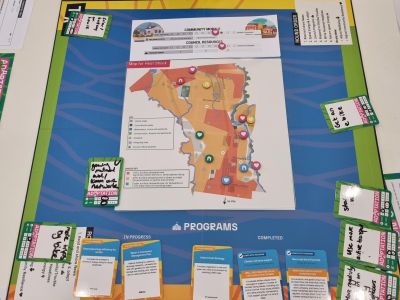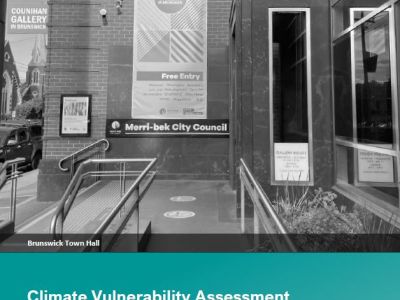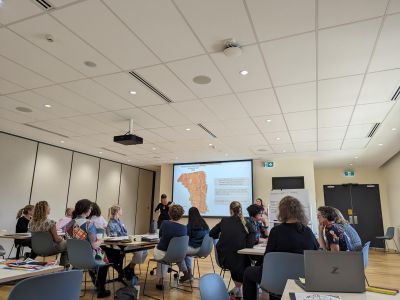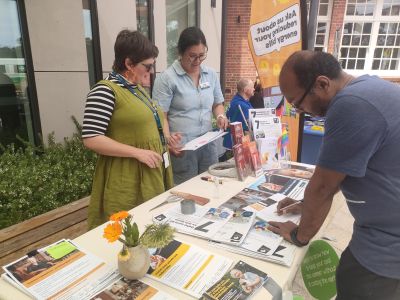Have a Peek into our Recent Work
We used The Adaptation Game to help our staff better understand climate change impacts.
We ran a series of workshops to help carers of babies learn first aid and protect them for heat stress.
We assessed Council-owned community buildings for their ability to cope under climate change.
We had a workshop with community services providers in Glenroy and Fawkner to think through ways of supporting the community through extreme heat.
We compiled different data sets and maps related to climate change to help us inform our decisions.
We talk to the community on how to keep safe when it's hot.
Our success in numbers
Together with related action plans, we are managing climate risk in Merri-bek in our corporate processes, our built and natural environments, our services, and more broadly in our community.
Progress Scorecard
We developed a scorecard to track our capacity as an organisation to manage climate risks across each of our 5 goals. The scorecard approach was tweaked based on the Adaptive Capacity Checklist - NAGA. Here is where we are in 2025.
Goal 1
By 2025, Council has iterative risk management, reporting and decision-making processes in place to manage climate-related risk to assets, service delivery, finances, and liabilities.
Ratings
-
Timeline item 1 - complete
Beginning to build capacity
There is no information available to officers on climate risks in the municipality
-
Timeline item 2 - complete
Emerging capacity
Information provided, and training delivered to officers on climate risks in the municipality.
-
Timeline item 3 - complete
Establishing capacity
Information is used in risk management processes and service planning.
-
Timeline item 4 - active
Consolidating capacity
Climate risk and resilience is well integrated into strategies, policies, and planning.
-
Timeline item 5 - incomplete
Succeeding and obtaining resilience benefits
Beyond integration into policies, robust climate risk and resilience integration into operational processes (e.g. budget planning, risk escalations, and business cases) and resulting in more robust decision-making.
Goal 2
By 2030, Council has improved the ability of its infrastructure, open spaces and natural environments to avoid, withstand and recover from.
Ratings
-
Timeline item 1 - complete
Beginning to build capacity
There are no initiatives and investment in understanding climate impacts to the infrastructure, open spaces, and natural environments.
-
Timeline item 2 - complete
Emerging capacity
Infrastructure vulnerability assessments are conducted to understand climate impacts.
-
Timeline item 3 - active
Establishing capacity
Some trial works (upgrades and refurbishment) delivered to improve building and infrastructure performance to satisfactory service levels for high-risk buildings and infrastructure
-
Timeline item 4 - incomplete
Consolidating capacity
Council has developed a work program to improve resilience in the built environment and open space and environment.
-
Timeline item 5 - incomplete
Succeeding and obtaining resilience benefits
Processes and systems are in place to address climate risk in capital works delivery of investments into infrastructure, open spaces, and natural environments.
Goal 3
By 2030, Council services are resilient to climate impacts such that we can support our community through the shocks and stressors associated with climate change.
Ratings
-
Timeline item 1 - complete
Beginning to build capacity
There are no Council initiatives and investment in understanding climate impacts to services.
-
Timeline item 2 - complete
Emerging capacity
Service assessments for a sample of core services are conducted.
-
Timeline item 3 - active
Establishing capacity
Service assessments and planning for an expanded number of core services are conducted.
-
Timeline item 4 - incomplete
Consolidating capacity
Recommendations from assessments are delivered through operational plans and actions.
-
Timeline item 5 - incomplete
Succeeding and obtaining resilience benefits
Services are reporting high adaptive capacity, using the adaptive capacity checklist developed by the Victorian Climate Resilient Councils.
Goal 4
By 2030, Merri-bek residents and businesses have access to relevant and appropriate information and support from Council to take meaningful action to adapt and build resilience to climate change.
Ratings
-
Timeline item 1 - complete
Beginning to build capacity
No initiatives or partnerships related to climate.
-
Timeline item 2 - complete
Emerging capacity
Baseline community adaptive capacity is assessed
-
Timeline item 3 - active
Establishing capacity
Opportunities for information sharing and support are mapped out.
-
Timeline item 4 - incomplete
Consolidating capacity
Community and businesses are informed on climate risks and adaptation actions to reduce risks.
-
Timeline item 5 - incomplete
Succeeding and obtaining resilience benefits
Community and business have uptake of adaptation actions.
Goal 5
By 2030, Council collaborates with and influences a range of private, community and public sector partners to drive adaptation and build climate resilience in Merri-bek.
Ratings
-
Timeline item 1 - complete
Beginning to build capacity
Council does not yet work with partners to drive adaptation and resilience.
-
Timeline item 2 - complete
Emerging capacity
Council participates in networks to coordinate, share information, and showcase work of Merri-bek.
-
Timeline item 3 - complete
Establishing capacity
Council collaborates with partners in projects that result in shared outputs.
-
Timeline item 4 - active
Consolidating capacity
Partnerships are delivering tangible outcomes in two out of the four areas: advocacy, grants and partnerships, procurement, and private developments.
-
Timeline item 5 - incomplete
Succeeding and obtaining resilience benefits
Partnerships are delivering tangible outcomes in four out of the four areas: advocacy, grants and partnerships, procurement, and private developments.
Partnerships are delivering tangible benefits or advocacy positions are adopted by relevant authorities.
All gold projects consider climate risk in their design and procurement.
Service provider networks are reporting high adaptive capacity.
Measures to ensure improved planning permit compliance are effective resulting in % increase in compliance
Our achievements so far
In line with our aim for accountability in managing climate risk, we commissioned an independent review to help assess our progress and how we are tracking on our goals.
Some of the findings of the review were:
Some of the barriers to implementation were:
- Lack of staff resourcing on top of existing workloads
- Needing to get alignment on the requirements of the actions
- Lack of specific knowledge particularly relating to the financial impacts of climate change.
The review also made recommendations, particularly for actions areas that face implementation challenges.
We are currently working through these recommendations and how they could practically inform the next actions and implementation for 2025 – 2030.
Key Areas to continue work on
We understand some of the types of climate-related events and the magnitude of costs to Council. We will aim towards more systematically quantifying the financial impacts of climate change across a range of assets, operations, and services, and additional costs to the capital works program. We will focus on areas of our most important climate risks. We will do this because we want to make sure that Council is in a good financial position to cope with climate change and to continue to provide community services.
We will continue to look at our existing assets, particularly those which are vulnerable and exposed to climate risk. We will develop prioritisation frameworks to support our investment decisions on asset maintenance, renewals, and upgrades. We will do this so that assets can maintain or improve their service levels and performance.
We will continue to inform the community on climate risks and how to adapt, particularly extreme heat and flood or stormwater risk. We will work with partners such as the State Emergency Services. Our work will focus on providing information to support people who may be disproportionally affected such as older people, babies and children, and culturally and linguistically diverse people.
Next Steps
Instead of developing a new Climate Risk Action Plan a more holistic Climate Emergency Action Plan has been developed. This plan includes priority actions that help implement our Climate Risk Strategy and helps to integrate and streamline our plans and action.
The specific actions that are related the Climate Risk Strategy are:
Reduce impacts of urban heat and increasing heatwaves by collaborating to get more shade trees in places like schools, retirement villages, and backyards.
Explore and progress ‘Resilient Neighbourhood Hub’ model in an at-risk neighbourhood.
Embed climate risk assessment and resilience considerations into all relevant Council strategies, policies, planning instruments, asset management, and operational decision-making











